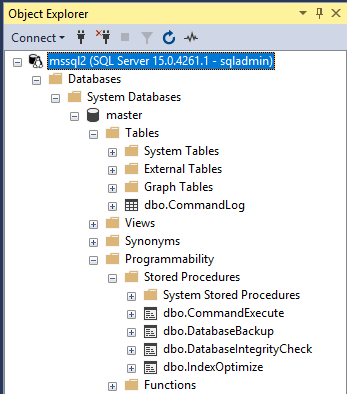Today, my colleague wanted to quickly test out some dbatools commands to install the Ola Hallengren maintenance solution. They had a local instance of SQL installed, but it already had the maintenance jobs running, so it wasn’t a fresh, out of the box instance.
So let’s spin a SQL Server instance in seconds to test against! (Ok it’s seconds if you have the pre-requisites installed, but I’ll get you setup in a few minutes if not)!
Pre-requisites
Now, for this you’re going to need a container platform installed on your laptop. The most popular is Docker Desktop, this is free for personal use at the time of writing. You could also look into podman, which is open-source.
Either way, download your chosen tool and follow the installation instructions. Both tools have good documentation, and a quickstart guide to get you running your first container.
Once this is working we can move onto the SQL Server part.
Spin up a SQL Server
So, now we have the container platform installed and configured, all we need to do is pull down a SQL Server image, spin up the container and get testing.
The Microsoft Docs have a quickstart for running a SQL Server container, you can review that here: Quickstart: Run SQL Server Linux container images with Docker.
But, this is a plain instance, no databases, no logins, SQL Agent isn’t configured - this isn’t always the easiest instance to test against.
Enter the dataplat organisation
The dataplat organisation on GitHub, and specifically Chrissy LeMaire have created some containers which already come preconfigured with sample databases, logins, and more. These mean that for most testing scenarios you have what you need to get started.
There is a discussion on the dbatools repo if you want to see other examples on how to use these containers, for example setting up a test availability group: dbatools and docker (updated!).
There are two containers available, both use the same admin login to connect, both are SQL Server 2019 (at the time of writing). The difference is whether you want sample databases and logins or not, if you do pick the dbatools/sqlinstance image, for a plainer image pick dbatools/sqlinstance2.
Alright, here is the magic
- Run the container. In my example we wanted to install Ola’s maintenance solution, that is already on the
sqlinstanceimage, so we chosesqlinstance2. The only part you might want to change is the port on your local computer.
| |
This docker run command is mapping port 1433 within the container, to port 2600 on my local computer. SQL Server listens on port 1433 by default, so what this means is that from my machine I will now connect to SQL on port 2600. You can choose any port, that isn’t in use.
- Create a connection to the instance. Since this is a container we’re going to use SQL Authentication, so I find it easiest to do the following to save a connection and then reuse that in my other dbatools commands.
The username and password is the same for all the dbatools images, since these are just local containers.
- user: sqladmin
- password: dbatools.IO
| |
Your console should look similar to this, you can see an object is returned showing that I am connected.

We are connected to our SQL Instance
If you get an error like the one below you need to verify the encryption settings for your session. You can read more about that here, as it was a change with dbatools 2.0. The easiest option is to add the -TrustServerCertificate parameter to the call of Connect-DbaInstance, since this is a local container this is low risk, however make sure you understand why this is needed for production servers.
Error connecting to [localhost,2600]: The certificate chain was issued by an authority that is not trusted.
- Get testing! You can now run any of the dbatools commands* (see Caveats below) against your instance, and test out how the parameters work, and ensure the results you’re getting are what you wanted.
| |

Ola maintenance solution is installed!
But I want to connect in SSMS\ADS
Good news! You can connect to this local container using any of your favourite tools. You’ll need to use SQL Authentication, and use the credentials shared above. The server name will be localhost:2600 where 2600 is the port you chose in the docker run command.

Ola maintenance solution shown through SSMS Object Explorer!
Two more tips
You can also setup client aliases to make connecting to the container even easier. I always run my containers on ports 2500 and 2600 so I set up client aliases, so I don’t have to use localhost:2600, instead I can use a friendly name.
Make sure you run this in an elevated console window, but after executing this you can now use mssql2 as the name to connect to your SQL Server instance.
| |
The second tip I’ve already blogged about, but it makes authenticating with containers easier. Read about using PSDefaultParameterValues for connecting to SQL Server containers.
Caveats
There are a couple of caveats to be aware of. Firstly, these containers are linux based, which means you can only test things that work on SQL Server running on Linux. There are fewer things on this list than you’d probably imagine, you can review the documentation here: Unsupported features and services.
Also, if you are trying to test anything performance related, remember these are small instances running on your laptop resources. Things are going to perform very different than on enterprise level hardware. You can still do some testing, but make sure the final tests are on a similar environment to whatever production might look like.
Now it’s even easier to get SQL Server containers
During the writing of this blog post, I found this post on LinkedIn, by Drew Skwiers-Koballa, he’s made a docker extension to allow you to quickly spin up an instance. Now these won’t get you all the dbatools extras, but will get you an instance in no time at all.
Check that post out on LinkdedIn!
